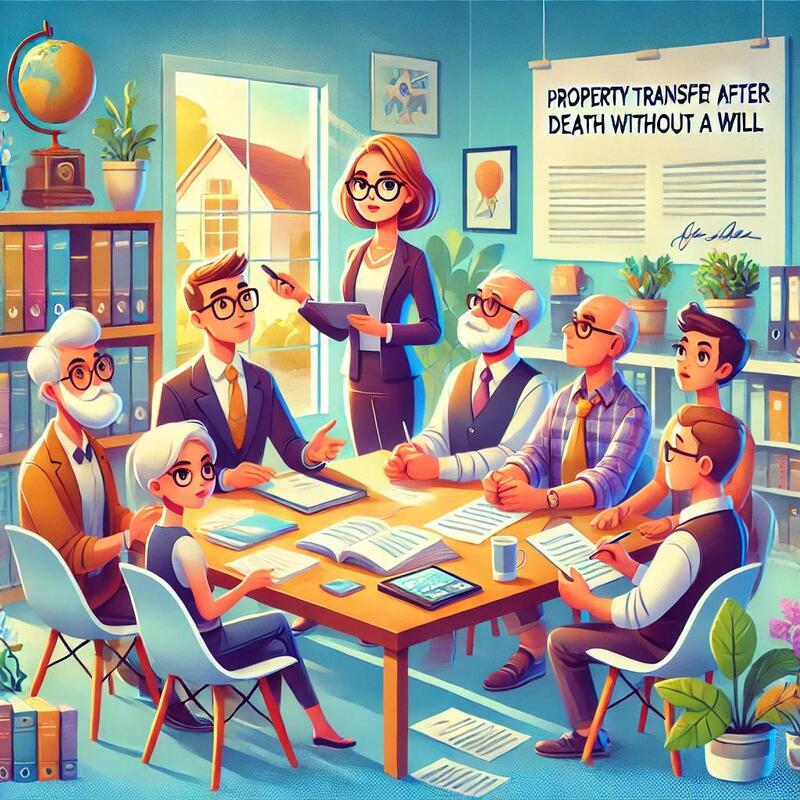Transfer of Property After Death Without a Will: Key Steps Explained
Learn the essential steps for transferring property after a death without a will. Ensure smooth estate planning with key insights on intestate succession, probate, and safeguarding digital assets.

Transfer of Property After Death Without a Will: Key Steps Explained
When someone passes away without a will, their property does not automatically go to their family or intended heirs. Instead, the transfer of assets is governed by a legal process known as intestate succession. This process can vary depending on state laws and whether the person who passed away had any close relatives. Here's a breakdown of the key steps involved when transferring property after death without a will.
1. Understand Intestate Succession Laws #
In the absence of a will, the state's intestate succession laws will determine how the deceased's property is distributed. Typically, close relatives such as a surviving spouse, children, or parents will inherit first. If no close relatives are alive, more distant relatives may inherit. The exact distribution depends on state laws and family relationships.
2. Appoint a Court-Approved Administrator #
Since there is no will to name an executor, the court will appoint an administrator to oversee the estate settlement. This administrator will manage the transfer of property and ensure that all legal requirements are met, including paying any outstanding debts and taxes.
3. Determine the Heirs #
Before the property can be distributed, the heirs must be identified based on the state's intestate succession laws. This often involves verifying family relationships through birth certificates, marriage records, or other documentation.
4. Probate Process #
The next step is to go through probate, a court-supervised process to settle the deceased's estate. During probate, the court ensures that debts and taxes are paid, and the remaining assets are distributed to the heirs. Probate can be a lengthy and costly process, which is why many people use estate planning documents to avoid it.
5. Property Transfer and Taxes #
Once the probate process is complete, the property will be officially transferred to the heirs. This may include real estate, bank accounts, and other assets. Depending on the size of the estate, there may be federal and state taxes to pay before the transfer can occur.
6. Protecting Digital Assets #
In today’s digital age, many people leave behind important online accounts and digital assets. Without a digital estate plan, these assets can be lost or go unclaimed. Utilizing services like WillBox.me can help ensure that these assets are included in the estate transfer process.
Ensure Your Estate Is Protected – Start Planning with Willbox Today!
Transferring property after a death without a will can be a complex and often stressful process, especially when navigating intestate succession laws, probate proceedings, and dealing with digital assets. However, by understanding the key steps and preparing accordingly, you can ensure a smoother transition for your loved ones. Protecting your estate through proper planning, including a well-organized digital estate plan, can help avoid unnecessary delays and expenses in the future. It’s never too early to start planning, and taking these steps now can bring peace of mind to both you and your family.
At WillBox, we make estate planning simple and secure. From managing your digital assets to safeguarding essential documents, our platform provides everything you need to organize your estate effectively. Don’t leave your loved ones navigating the complexities of intestate succession – consider visiting WillBox.me and start your lasting digital legacy now!
Subscribe to WillBox.me Digital Legacy Service #
Join our community to preserve and share your memories with those who matter most.
Click here to subscribe to our service.
Frequently Asked Questions About Transferring Property Without a Will #
Q1. What happens if no relatives are found? #
If no relatives can be located, the property may escheat, meaning it becomes the property of the state.
Q2. Can digital assets be transferred after death? #
Yes, with proper planning. A digital estate plan can ensure online accounts, cryptocurrencies, and intellectual property are passed on to beneficiaries. Learn more about managing digital inheritance here.
Q3. How does the probate process work for intestate estates? #
Probate is a court process to settle the deceased’s estate, including identifying heirs, paying debts, and distributing assets. Without a will, probate ensures that assets are transferred based on intestate succession laws.
Q4. How can I protect my assets without a will? #
To protect your assets and ensure they are distributed according to your wishes, consider setting up a will or trust and organizing your estate planning documents here.
Q5. What is the role of an estate administrator? #
An estate administrator, appointed by the court, handles the legal process of distributing assets, paying debts, and ensuring all taxes are settled.
Our service #
At WillBox.me, we provide a complete digital estate planning service that helps you organize and manage your digital assets, so they can be accessed and transferred by your loved ones after you pass away or become incapacitated. Our service includes creating a digital inventory, determining who will have access, providing instructions on how to manage your assets, and securely storing your digital estate plan.
Subscribe to our service today, and gain peace of mind that your legacy will be protected.
Subscribe to WillBox.me Digital Legacy Service
Join our community to preserve and share your memories with those who matter most.
Click here to subscribe to our service.